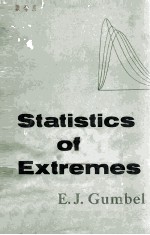

Statistics of ExtremesPDF电子书下载
- 电子书积分:13 积分如何计算积分?
- 作 者:E.J.Gumbel
- 出 版 社:Columbia University Press
- 出版年份:1958
- ISBN:
- 页数:375 页
Chapter One:AIMS AND TOOLS 1
1.0.Aims 1
1.0.1.Conditions 1
1.0.2.History 2
1.0.3.The Flood Problem 4
1.0.4.Methodology 5
1.0.5.Arrangement of Contents 5
1.1.General Tools 7
1.1.1.Linear Transformations 7
1.1.2.Other Transformations 7
1.1.3.Symmetry 8
1.1.4.Measures of Dispersion 9
1.1.5.Moments 10
1.1.6.Generating Function 11
1.1.7.Convolution 13
1.1.8.The Gamma Function 15
1.1.9.The Logarithmic Normal Distribution 16
1.2.Specific Tools 20
1.2.0.Problems 20
1.2.1.The Intensity Function 20
1.2.2.The Distribution of Repeated Occurrences 21
1.2.3.Analysis of Return Periods 26
1.2.4."Observed"Distributions 28
1.2.5.Construction of Probability Papers 28
1.2.6.The Plotting Problem 29
1.2.7.Conditions for Plotting Positions 32
1.2.8.Fitting Straight Lines on Probability Papers 34
1.2.9.Application to the Normal Distribution 38
Chapter Two:ORDER STATISTICS AND THEIR EXCEEDANCES 42
2.1.Order Statistics 42
2.1.0.Problems 42
2.1.1.Distributions 42
2.1.2.Averages 43
2.1.3.Distribution of Frequencies 46
2.1.4.Asymptotic Distribution of mth Central Values 47
2.1.5.The Order Statistic with Minimum Variance 51
2.1.6.Control Band 52
2.1.7.Joint Distribution of Order Statistics 53
2.1.8.Distribution of Distances 55
2.2.The Distribution of Exceedances 57
2.2.0.Introduction 57
2.2.1.Distribution of the Number of Exceedances 58
2.2.2.Moments 61
2.2.3.The Median 63
2.2.4.The Probability of Exceedances as Tolerance Limit 64
2.2.5.Extrapolation from Small Samples 67
2.2.6.Normal and Rare Exceedances 69
2.2.7.Frequent Exceedances 72
2.2.8.Summary 73
Chapter Three:EXACT DISTRIBUTION OF EXTREMES 75
3.1.Averages of Extremes 75
3.1.0.Problems 75
3.1.1.Exact Distributions 75
3.1.2.Return Periods of Largest and Large Values 78
3.1.3.Quantiles of Extremes 79
3.1.4.Characteristic Extremes 82
3.1.5.The Extremal Intensity Function 84
3.1.6.The Mode 85
3.1.7.Moments 87
3.1.8.The Maximum of the Mean Largest Value 89
3.2.Extremal Statistics 94
3.2.0.Problems 94
3.2.1.Absolute Extreme Values 94
3.2.2.Exact Distribution of Range 97
3.2.3.The Mean Range 100
3.2.4.The Range as Tolerance Limit 103
3.2.5.The Maximum of the Mean Range 106
3.2.6.Exact Distribution of the Midrange 108
3.2.7.Asymptotic Independence of Extremes 110
3.2.8.The Extremal Quotient 111
Chapter Four:ANALYTICAL STUDY OF EXTREMES 113
4.1.The Exponential Type 113
4.1.0.Problems 113
4.1.1.Largest Value for the Exponential Distribution 113
4.1.2.Order Statistics for the Exponential Distribution 116
4.1.3.L'Hopital's Rule 118
4.1.4.Definition of the Exponential Type 120
4.1.5.The Three Classes 122
4.1.6.The Logarithmic Trend 123
4.1.7.The Characteristic Product 125
4.2.Extremes of the Exponential Type 126
4.2.0.Problems 126
4.2.1.The LOgistic Distribution 126
4.2.2.Normal Extremes,Numerical Values 129
4.2.3.Analysis of Normal Extremes 136
4.2.4.Normal Extreme Deviates 140
4.2.5.Gamma Distribution 143
4.2.6.Logarithmic Normal Distribution 146
4.2.7.The Normal Distribution as a Distribution of Extremes 147
4.3.The Cauchy Type 149
4.3.0.Problems 149
4.3.1.The Exponential Type and the Existence of Moments 149
4.3.2.Pareto's Distribution 151
4.3.3.Definition of the Pareto and the Cauchy Types 152
4.3.4.Extremal Properties 153
4.3.5.Other Distributions without Moments 154
4.3.6.Summary 155
Chapter Five:THE FIRST ASYMPTOTIC DISTRIBUTION 156
5.1.The Three Asymptotes 156
5.1.0.Introduction 156
5.1.1.Preliminary Derivation 156
5.1.2.The Stability Postulate 157
5.1.3.Outline of Other Derivations 162
5.1.4.Interdependence 164
5.2.The Double Exponential Distribution 166
5.2.0.Introduction 166
5.2.1.Derivations 166
5.2.2.The Methods of Cramér and Von Mises 170
5.2.3.Mode and Median 172
5.2.4.Generating Functions 173
5.2.5.Standard and Mean Deviations 174
5.2.6.Probability Paper and Return Period 176
5.2.7.Comparison with Other Distributions 179
5.2.8.Barricelli's Generalization 184
5.3.Extreme Order Statistics 187
5.3.0.Problems 187
5.3.1.Distribution of the mth Extreme 187
5.3.2.Probabilities of the mth Extreme 189
5.3.3.Generating Functions 192
5.3.4.Cramér's Distribution of mth Extremes 194
5.3.5.Extreme Distances 197
5.3.6.The Largest Absolute Value and the Two Sample Problem 198
Chapter Six:USES OF THE FIRST ASYMPTOTE 201
6.1.Order Statistics from the Double Exponential Distribution 201
6.1.0.Problems 201
6.1.1.Maxima of Largest Values 201
6.1.2.Minima of Largest Values 203
6.1.3.Consecutive Modes 206
6.1.4.Consecutive Means and Variances 208
6.1.5.Standard Errors 212
6.1.6.Extension of the Control Band 216
6.1.7.The Control Curve of Dick and Darwin 218
6.2.Estimation of Parameters 219
6.2.0.Problems 219
6.2.1.Exponential and Normal Extremes 219
6.2.2.Use of Order Statistics 223
6.2.3.Estimates for Probability Paper 226
6.2.4.Sufficient Estimation Functions&by B.F.Kimball 229
6.2.5.Maximum Likelihood Estimations&by B.F.Kimball 231
6.2.6.Approximate Solutions 232
6.2.7.Asymptotic Variance of a Forecast&by B.F.Kimball 234
6.3.Numerical Examples 236
6.3.0.Problems 236
6.3.1.Floods 236
6.3.2.The Design Flood 238
6.3.3.Meteorological Examples 241
6.3.4.Application to Aeronautics 245
6.3.5.Oldest Ages 246
6.3.6.Breaking Strength 248
6.3.7.Breakdown Voltage 249
6.3.8.Applications to Naval Engineering 251
6.3.9.An Application to Geology 254
Chapter Seven:THE SECOND AND THIRD ASYMPTOTES 255
7.1.The Second Asymptote 255
7.1.0.Problems 255
7.1.1.Fréchet's Derivation 255
7.1.2.The Cauchy Type 259
7.1.3.Averages and Moments 264
7.1.4.Estimation of the Parameters 266
7.1.5.The Increase of the Extremes 269
7.1.6.Generalization 270
7.1.7.Applications 271
7.1.8.Summary 272
7.2.The Third Asymptote 272
7.2.0.Introduction 272
7.2.1.The Von Mises Derivation 273
7.2.2.Other Derivations 276
7.2.3.Averages and Moments of Smallest Values 280
7.2.4.Special Cases 285
7.2.5.The Increase of the Extremes 287
7.2.6.The 15 Relations Among the 3 Asymptotes 288
7.3.Applications of the Third Asymptote 289
7.3.0.Problems 289
7.3.1.Estimation of the Three Parameters 289
7.3.2.Estimation of Two Parameters 293
7.3.3.Analytical Examples 298
7.3.4.Droughts 299
7.3.5.Fatigue Failures 302
Chapter Eight:THE RANGE 306
8.1.Asymptotic Distributions of Range and Midrange 306
8.1.0.Problems 306
8.1.1.The Range of Minima 307
8.1.2.Generating Function of the Range 308
8.1.3.The Reduced Range 309
8.1.4.Asymptotic Distribution of the Midrange 311
8.1.5.A Bivariate Transformation 312
8.1.6.Asymptotic Distribution of the Range 316
8.1.7.Boundary Conditions 320
8.1.8.Extreme Ranges 321
8.1.9.Summary 324
8.2.Extremal Quotient and Geometric Range 324
8.2.0.Problems 324
8.2.1.Definitions 325
8.2.2.The Extremal Quotient 326
8.2.3.The Geometric Range 327
8.3.Applications 331
8.3.0.Problems 331
8.3.1.The Midrange 331
8.3.2.The Parameters in the Distribution of Range 333
8.3.3.Normal Ranges 336
8.3.4.Estimation of Initial Standard Deviation 338
8.3.5.Climatological Examples 340
Summary 345
Bibliography 349
Index 373
- 《中国“80后”大学教师胜任力评价研究=RESEARCH ON THE EVALUATION OF CHINA'S POST 80s GENERATION UNIVERSITY TEACHERS' CO》黄艳著 2013
- 《解读好莱坞:电影的空间与意义》Deborah Thomas著;李达义,曹玉玲译 2004
- 《会说话的星图 星座篇》徐历涛著 2014
- 《可靠性工程与风险管理 第3辑 英文版》赵衍刚编 2012
- 《竞争战略 全译珍藏版》(美)迈克尔·波特(Michael E. Porter)著 2012
- 《中国材料名师讲坛 第1辑》谢建新主编 2012
- 《翻译能力的培养》舍夫娜,阿达巴编 2012
- 《大学生外语口语焦虑 自我图式的视角 for university students: in the view of self-schema》巫文胜著 2014
- 《都柏林大学的教育内涵与实践 探索世界高水平大学发展之路 explore the development of the world high-level university》李全宏编著 2013
- 《物理学 卷1 力学和热学 医学、生物等专业适用 英文改编版原书第4版》AlanGiambattista,BettyMcCarthyRichardson著 2013
